Smart Cruise Control malfunction and limitations
Smart Cruise Control malfunction
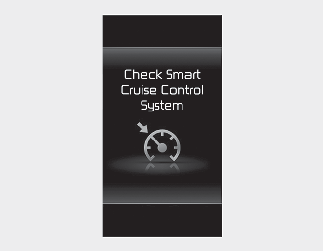
When Smart Cruise Control is not working properly, the warning message will appear for several seconds and the  warning light will appear on the cluster. In this case, have Smart Cruise Control inspected by an authorized Kia dealer.
warning light will appear on the cluster. In this case, have Smart Cruise Control inspected by an authorized Kia dealer.
Smart Cruise Control disabled
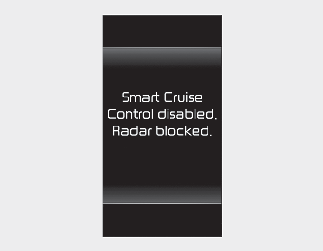
When the front radar cover or sensor is covered with snow, rain, or foreign matters, it can reduce the detecting performance and temporarily limit or disable Smart Cruise Control.
If this occurs, the warning message will appear for a certain period of time on the cluster.
Smart Cruise Control will operate properly when such snow, rain or foreign matter is removed. Always keep it clean.

Even though the warning message does not appear on the cluster, Smart Cruise Control may not properly operate.

Smart Cruise Control may not properly operate in an area (for example, open terrain), where any objects are not detected after turning ON the engine.
Limitations of Smart Cruise Control
Smart Cruise Control may not operate properly or it may operate unexpectedly under the following circumstances:
-
The detecting sensor or the surroundings are contaminated or damaged
-
Washer fluid is continuously sprayed, or the wiper is on
-
The camera lens is contaminated due to tinted, filmed or coated windshield, damaged glass, or stuck of foreign matters (sticker, bug, etc.) on the glass
-
Moisture is not removed or frozen on the windshield
-
The field of view of the front view camera is obstructed by sun glare
-
Street light or light from an oncoming vehicle is reflected on the wet road surface, such as a puddle in the road
-
The temperature around the front view camera is high or low
-
An object is placed on the dashboard
-
The surrounding is very bright
-
The surrounding is very dark, such as in a tunnel, etc.
-
The brightness changes suddenly, for example when entering or exiting a tunnel
-
The brightness outside is low, and the headlamps are not on or are not bright
-
Driving in heavy rain or snow, or thick fog
-
Driving through steam, smoke or shadow
-
Only part of the vehicle is detected
-
The vehicle in front has no tail lights, tail lights are located unusually, etc.
-
The brightness outside is low, and the tail lamps are not on or are not bright
-
The rear of the front vehicle is small or does not look normal (for example, tilted, overturned, etc.)
-
The front vehicle's ground clearance is low or high
-
Your vehicle is being towed
-
A vehicle suddenly cuts in front
-
Driving through a tunnel or railroad bridge
-
An object reflecting off the front radar such as a guardrail, nearby vehicle, etc.
-
The bumper around the front radar is impacted, damaged or the front radar is out of position
-
The temperature around the front radar is high or low
-
Driving in vast areas where there are few vehicles or structures (for example, desert, meadow, suburb, etc.)
-
The vehicle in front is made of material that does not reflect on the front radar
-
Driving near a highway (or motorway) interchange or tollgate
-
Driving on a slippery surface due to snow, water puddle, ice, etc.
-
Driving on a curved road
-
The vehicle in front is detected late
-
The vehicle in front is suddenly blocked by a obstacle
-
The vehicle in front suddenly changes lane or suddenly reduces speed
-
The vehicle in front is bent out of shape
-
The front vehicle's speed is fast or slow
-
With a vehicle in front, your vehicle changes lane at low speed
-
The vehicle in front is covered with snow
-
You are driving unstably
-
You are on a roundabout and the vehicle in front is not detected
-
You are continuously driving in a circle
-
Driving in a parking lot
-
Driving through a construction area, unpaved road, partial paved road, uneven road, speed bumps, etc.
-
Driving on an incline road, curved road, etc.
-
Driving through a roadside with trees or streetlights
-
The adverse road conditions cause excessive vehicle vibrations while driving
-
Your vehicle height is low or high due to heavy loads, abnormal tire pressure, etc.
-
Driving through a narrow road where trees or grass are overgrown
-
There is interference by electromagnetic waves, such as driving in an area with strong radio waves or electrical noise
-
Driving on a curved road
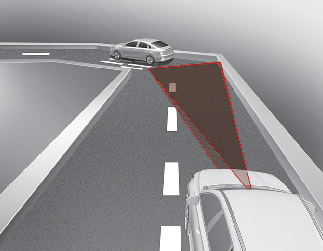
On curves, Smart Cruise Control may not detect a vehicle in the same lane, and may accelerate to the set speed. Also, vehicle speed may rapidly decrease when the vehicle ahead is detected suddenly.
Select the appropriate set speed on curves and apply the brake pedal or accelerator pedal according to the road and driving conditions ahead.
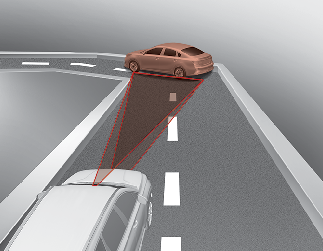
Your vehicle speed can be reduced due to a vehicle in the adjacent lane.
Apply the accelerator pedal and select the appropriate set speed. Check to be sure that the road conditions permit safe operation of Smart Cruise Control.
-
Driving on an inclined road
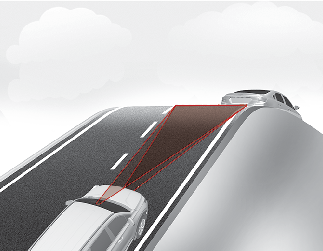
During uphill or downhill driving, Smart Cruise Control may not detect a moving vehicle in your lane, and cause your vehicle to accelerate to the set speed. Also, vehicle speed will rapidly decrease when the vehicle ahead is detected suddenly.
Select the appropriate set speed on inclines and apply the brake pedal or accelerator pedal according to the road and driving conditions ahead.
-
Changing lanes
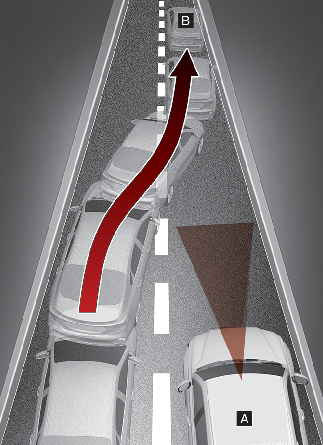
[A]: Your vehicle, [B]: Lane changing vehicle
When a vehicle moves into your lane from an adjacent lane, it cannot be detected by the sensor until it is in the sensor's detection range.
Smart Cruise Control may not immediately detect the vehicle when the vehicle changes lanes abruptly. In this case, you must maintain a safe braking distance, and if necessary, depress the brake pedal to reduce your driving speed in order to maintain a safe distance.
-
Detecting vehicle
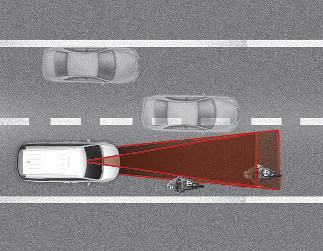
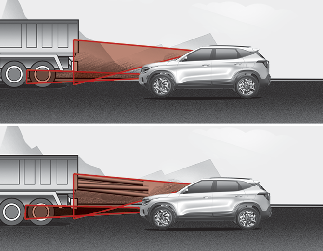
In the following cases, some vehicles in your lane cannot be detected by the sensor:
-
Vehicles offset to one side
-
Slow-moving vehicles or sudden-decelerating vehicles
-
Oncoming vehicles
-
Stopped vehicles
-
Vehicles with small rear profile, such as trailers
-
Narrow vehicles, such as motorcycles or bicycles
-
Special vehicles
-
Animals and pedestrians
In the following cases, the vehicle in front cannot be detected by the sensor:
-
Vehicles with higher clearance or vehicles carrying loads that stick out of the back of the vehicle
-
Vehicles that have the front lifted due to heavy loads
-
You are steering your vehicle
-
Driving on narrow or sharply curved roads
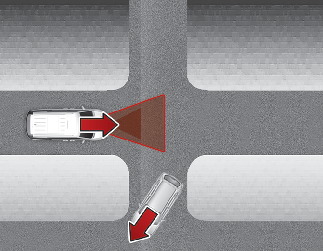
When a vehicle ahead disappears at an intersection, your vehicle may accelerate. Always pay attention to road and driving conditions while driving.
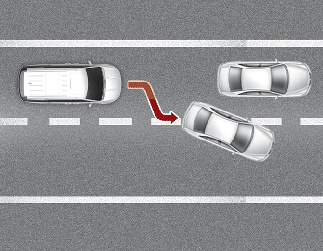
When a vehicle in front of you merges out of the lane, Smart Cruise Control may not immediately detect the new vehicle that is now in front of you. Always pay attention to road and driving conditions while driving.
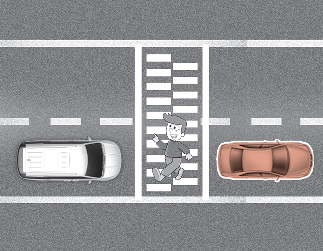
Always look out for pedestrian when your vehicle is maintaining a distance with the vehicle ahead.
This device complies with Part 15 of the FCC rules.
Operation is subject to the following three conditions:
-
This device may not cause harmful interference, and
-
This device must accept any interference received, including interference that may cause undesired operation.
-
Changes or modifications not expressly approved by the party responsible for compliance could void the user’s authority to operate the device.
Radio frequency radiation exposure information:
This equipment complies with FCC radiation exposure limits set forth for an uncontrolled environment. This equipment should be installed and operated with minimum distance of 8 in (20 cm) between the radiator (antenna) and your body.
This transmitter must not be co-located or operating in conjunction with any other antenna or transmitter.